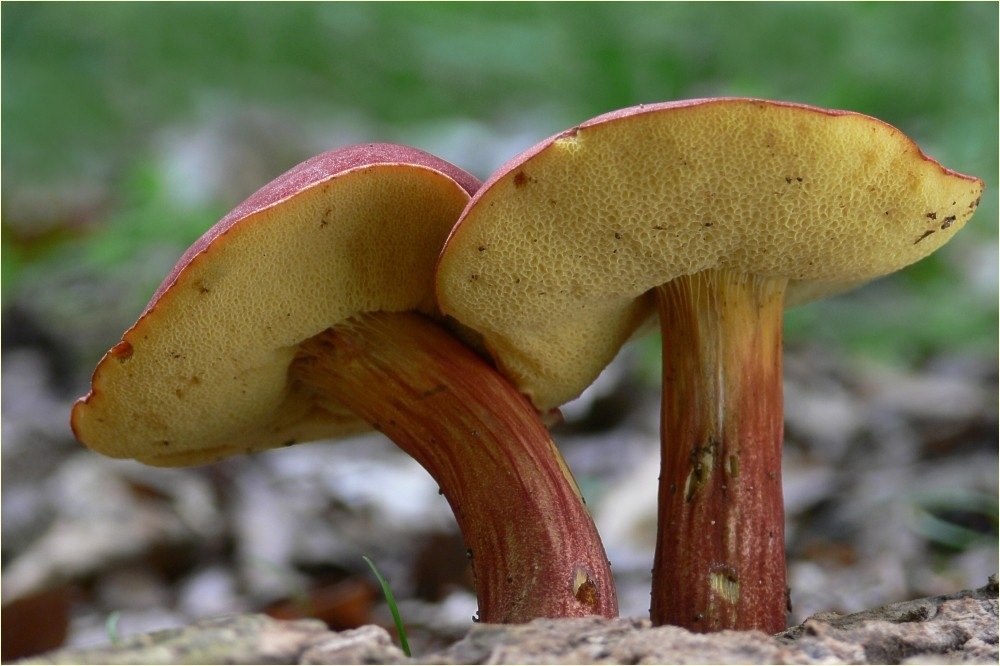

Podgrzybek czerwonawy (Xerocomellus rubellus)
Podgrzybek czerwonawy jest grzybem jadalnym. Jego cechą charakterystyczną jest intensywny czerwony kolor. W Polsce grzyb występuje bardzo rzadko.
Podgrzybek czerwonawy występuje w lasach liściastych, głównie pod dębami, lipami i brzozami. Można go także znaleźć na trawnikach w parkach. Rośnie w Europie i Ameryce Północnej.
Owocnik podgrzybka czerwonawego osiąga wielkość od 3 do 10 cm. średnicy. U młodych okazów przybiera różne odcienie czerwieni, najczęściej ma jednak kolor karminowoczerwony. Z wiekiem blednie i staje się różowomatowy. Kapelusz początkowo ma kształt półkolisty, później robi się rozpostarty i płaski. U starszych osobników jest pofałdowany. Ma suchą, zamszową powierzchnię, która w czasie suszy może pękać, ukazując żółty miąższ. Skóry nie da się oddzielić od miąższu.
Rurki osiągają długość od 6 do 15 mm. Przy trzonie są zatokowo wycięte. Są koloru zielonożółtego, po przecięciu sinieją. Pokryte są kanciastymi porami średniej wielkości.
Trzon borowika czerwonawego osiąga wysokość od 3 do 12 cm. i grubość od 4 do 25 mm. Przy trzonie i przy podstawie jest koloru żółtego, niekiedy przybiera barwę pomarańczową. W środkowej części pokryty jest czerwonymi smugami. Po uciśnięciu sinieje. Ma walcowaty kształt, na całej długości ma taką samą grubość. Często jest powyginany.
Miąższ borowika czerwonawego jest miękki, koloru żółtego, po przekrojeniu nieco błękitnieje. Ma słaby zapach i łagodny smak.
Starsze, wyblakłe egzemplarze czasem mylone są z podgrzybkiem złotawym.
Podgrzybek czerwonawy jest grzybem jadalnym. Świetnie nadaje się do marynowania oraz jako dodatek do dań mięsnych, sosów i zup

Hortiboletus rubellus, commonly known as the ruby bolete, is a small, dainty, brightly coloured member of the family Boletaceae, with a reddish cap and stipe, and yellow pores. Like many boletes, it stains blue when cut or bruised. It is found in deciduous woodland in autumn. There is some question over its edibility, and it is reportedly of poor quality with a taste of soap. Until 2015, the species was known as Boletus rubellus.
Boletus rubellus was one of the pored basidiomycetes to be placed in the genus Xerocomus in the past, and is still regarded as such in some texts. The previously commonly used binomial name Boletus versicolor (Rostk.), published in 1844, is now reduced to synonymy as it postdates the current name by German mycologist Julius Vincenz von Krombholz which dates from 1836. Its present specific epithet rubellus is Latin for "somewhat red". The fungus was transferred to the new genus Hortiboletus in 2015, following molecular evidence indicating its genetic dissimilarity to Boletus.
It is a small bolete, with the cap being rarely over 6 centimetres (2+3⁄8 in) in diameter. This cap is scarlet to raspberry red when young, with a dry velvety texture, often cracking in age. The extreme margin often has a pale yellow or white band around it, and it discolours darker and dirtier with age. The pores are small; pale yellow, and bruise slowly. Sometimes tapering, the stem is slender and long, and may reach 7.5 cm (3 in). It is lemon yellow at the apex, but red elsewhere, and has a tendency to split or sheer vertically. The flesh is straw-coloured in the cap, and stains slowly blue over the tubes when cut. The flesh of the stem is pale yellow at the apex and yellow further down. At the stem base, the flesh may have a distinct spot of brick-red or orange. The tubes and pores are large and lemon-yellow, and may be greenish tinged when older. The spore print is olive. It smells pleasant, but indistinct, and is said to taste slightly soapy.
Conflicting information on pore size in notable publications is a possible indication that there may be more than one species involved, both in Britain and in North America.
Uncommon to rare in Southern England, occurring largely with oak (Quercus). It also appears in Europe, and the Eastern United States and Canada. A similar species noted as "cf versicolor" has been collected from Victoria in southeastern Australia.


Aby rozwiązać zagadkę należy skompletować układankę :
To solve the puzzle, you need to complete the puzzle:
Podgrzybek czerwonawy (Xerocomellus rubellus)